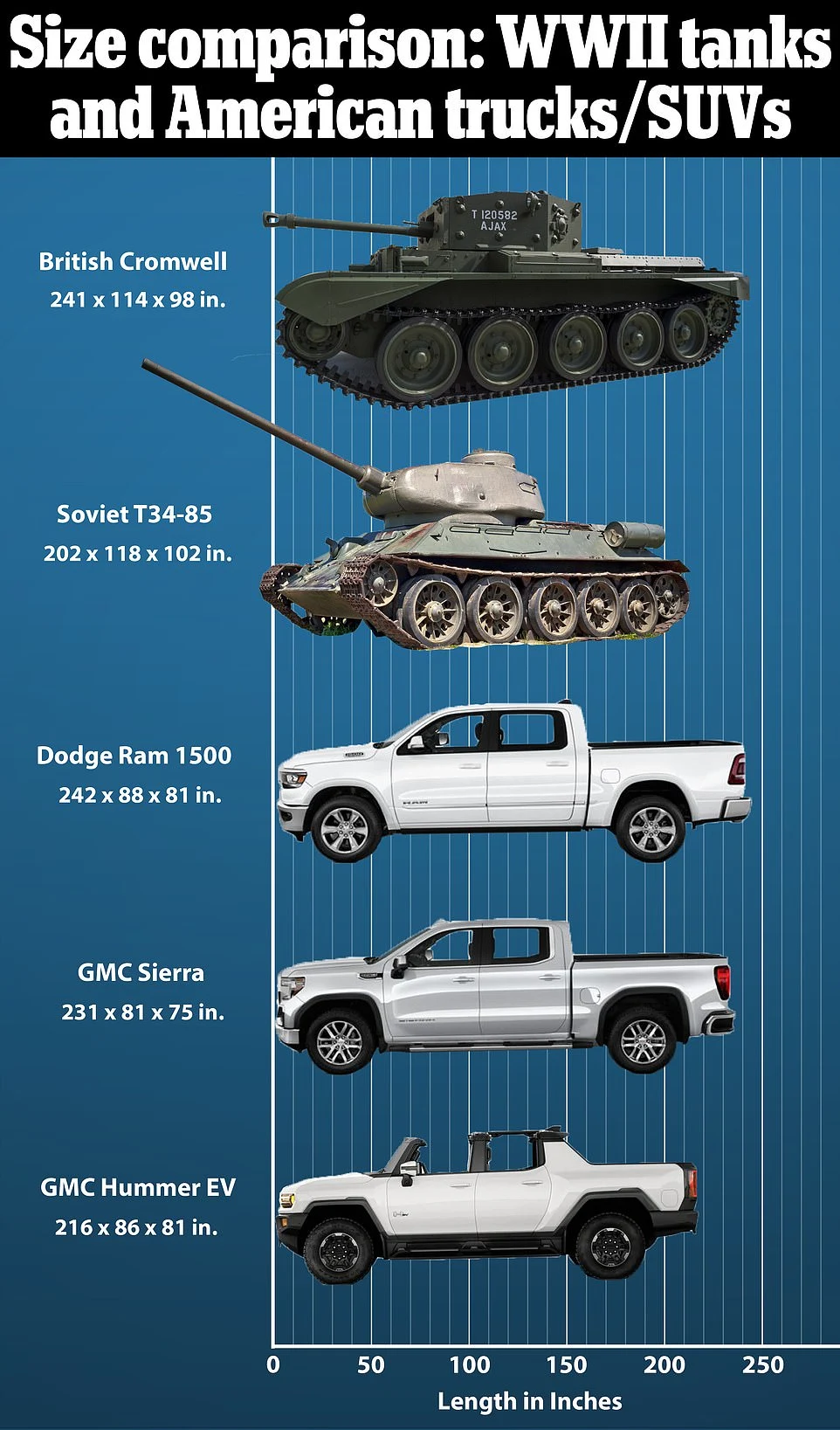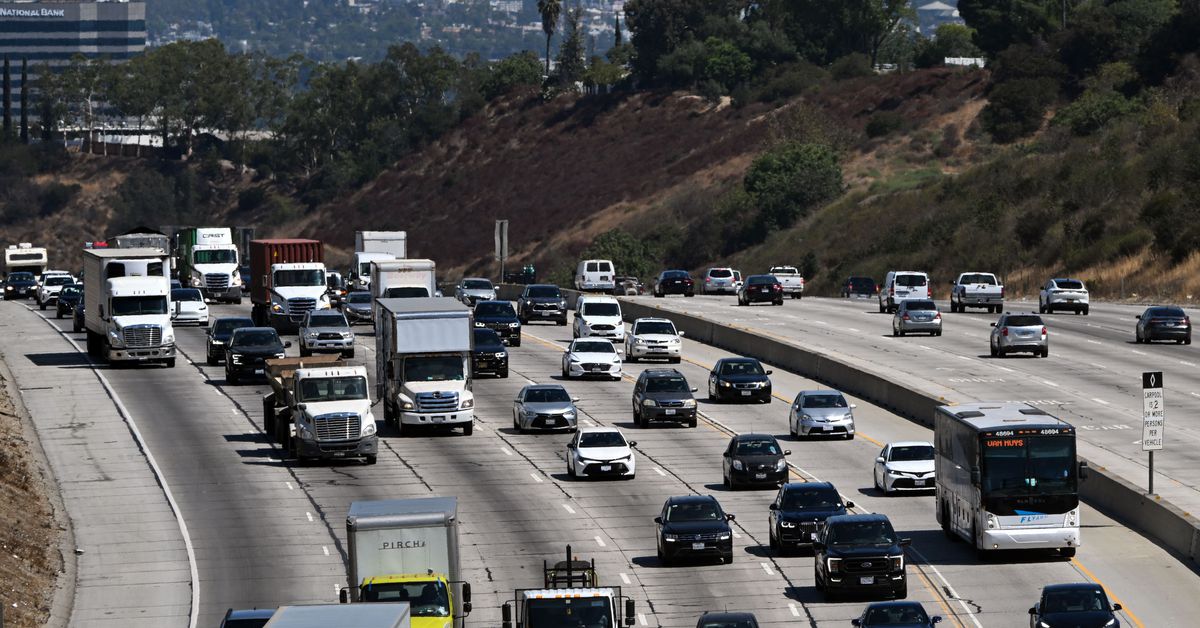deleted by creator
Yeah hah, they are largely not even in the race.
They are still able to sell SUVs and basically at this point road legal monster trucks to a consumer base that still cannot grasp the concept that they could do 99% of what they use a car for with a sedan or hatchback, and that 1% of the time just rent a uhaul… they could do that and save tons of money on gas with the greater fuel efficiency.
But American car owners are not exactly known for making rational decisions or being good drivers.
Much more important to flaunt status and lifestyle with a car.
Much more important.
The US government created this issue by exempting trucks and SUVs from fuel economy standards imposed on cars. That was the initial motivating factor behind car manufacturers pushing these large vehicles. Now it doesn’t upset car dealers that they can sell them for more money. Also, consumers feel safer in larger vehicles… largely because all the other vehicles on the road are now bigger and will do more harm to smaller vehicles. And, because it’s America, there is a special individualism factor baked in that prioritizes ego over rational sound decision making for the collective betterment of humanity and the environment.
Gonna be reeeeallly fun when all the people who daily drive these things realize:
Wait a minute…
what even is peak oil ?
WHAT?! Gas prices are basically never going to go down again and just keep going higher?!
-===-
My guess is they will then all start complaining about the lack of public transportation, having spent their entire lives voting against funding it.
deleted by creator
Buyers feel safer in a taller car, and car dealers are happy to sell this bullshit, even though SUVs are far more likely to roll over in a crash.
The reason people feel safer in a taller car is because of everyone else that has a tall car.
The driving american seems to use the mutually assured destruction doctrine from the cold war as a how to guide rather than a warning.
Worse, this is spreading ocer to Europe as well, though governments are starting to tax heavier vehicles more than normal vehicles, and that is fantastic.
One of the funniest things in the world to me is that I first saw an Aston Mini in I think the Bourne Identity in the late 00s. Or maybe it was some other Spy Thriller from around the same time?
Fast forward to today and there is now an American version, still called a Mini, that is just as big as every other SUV.
https://www.motorbiscuit.com/american-trucks-suvs-almost-bigger-world-war-ii-tanks/
These are not exactly precise, and I cannot believe I am actually citing the DailyMail, but you get the idea:


deleted by creator
I mean I agree that this should be done, but the problem is that basically that would instantly destroy what is left of the entire economy.
People and shipping business are operating on razor thin margins right now, and if the price of gas basically doubled in a 3 to 9 month period from ending all of the subsidies to oil and gas companies, basically logistics firms would go out of business, large retailers with their own shipping would make up the slack by cutting standards and raising consumer prices, and a huge amount of peoples personal budgets would collapse as they can no longer afford their daily commute.
This of course was and is the plan of oil and gas companies. You cannot double the price a what is functionally a drug the economy is and has been addicted to for quite a long time (cheap gas) without, at this point, life threatening withdrawals.
You are an idiot if you think the consumer base wants larger vehicles. It is the manufacturers who want larger vehicles. Widen a car’s stance by 3 inches and lengthen it by 6 inches, and it’s suddenly in a class that allows higher emissions and lower economy.
Every manufacturer has killed off all of their subcompact options rather than even trying to meet the tightening standards for that class. The perverse incentives they have push them to build bigger.
Paradoxically, the only thing that is going to bring back efficient subcompacts is eliminating economy requirements on the smallest, most efficient class of car, rather than tightening them.
deleted by creator
I do not deny that a segment of consumers want large cars. I, myself, have need for a 9+ passenger vehicle with a >10,000lb tow rating. A modern Suburban is actually too small to meet the needs of my summer and daytime business, which involves hauling customers and equipment across the county. But, I still have plenty of options on the market for that large vehicle.
But, my winter and nighttime business calls for a very small, very lightweight vehicle. 30-year-old subcompact designs are more fuel efficient and suitable for couriers (DoorDash, GrubHub, etc.) than anything currently being manufactured. I can’t buy a new subcompact vehicle: there is nothing currently on the market that ideally meets my business needs.
The closest I can find in terms of ideal size and weight would be a Japanese Kei truck, but maintenance would be a nightmare.
You are not getting an accurate picture of consumer preference, because the segment of the consumer base demanding small vehicles is not having its needs met.
Also, obligatory “Fuck Tesla”. Fuck their lack of door handles. Fuck their lack of buttons. Fuck their touchscreens. Fuck their quality and workmanship. And triple fuck the politics of their CEO.
I can’t buy a new subcompact vehicle: there is nothing currently on the market that ideally meets my business needs.
I’m curious what kind of “business need” you have that could be met by a subcompact from 30 years ago but NOT by a Chevy Bolt or Chevy EUV? Either of those have an mpge rating of more than DOUBLE what an old Honda Civic Hatchback or Kei truck could manage plus more cargo space than either of them! The Bolt’s are fairly inexpensive too, 2020 models can be bought used for less than $18,000 and 2017s for less than $14,000.
“More cargo space” is the battle cry of the “bigger is better” crowd, so I reject that argument outright.
Yes, the bolt has better economy. But, the 1990 Honda Civic was 20 inches shorter and 4 inches narrower. An updated Honda Civic with an equivalent drivetrain as the bolt would be smaller and lighter, and thus be getting even better mileage than the bolt.
Those extra 20 inches in length and 4 inches in width are necessary for the bolt to meet modern emissions standards. Shorten it by 20 inches and narrow it by 4, and Chevy wouldn’t be allowed to produce it, even though it would have a higher economy.
“More cargo space” is the battle cry of the “bigger is better” crowd, so I reject that argument outright.
Then I reject your consideration of a Kei Truck as cargo space obviously isn’t a concern for you.
But, the 1990 Honda Civic was 20 inches shorter and 4 inches narrower. An updated Honda Civic with an equivalent drivetrain as the bolt would be smaller and lighter…
Unrealistic as it could not be sold. A 1990 Honda Civic lacks crumple zones and other safety features that are now required on vehicles in the United States.
…and thus be getting even better mileage than the bolt.
Nope, the additional safety features make the footprint lager and the vehicle heavier.
Those extra 20 inches in length and 4 inches in width are necessary for the bolt to meet modern emissions standards.
Sigh, the Bolt doesn’t HAVE any emissions. It’s a straight EV. The extra size over a 1990 Honda Civic are for the required safety features and drivetrain.
Yes, the bolt has better economy.
So what’s the problem? A domestic auto manufacturer DOES in fact make something that would work and that something is superior in every way to a sub-compact from 30 years ago. Go buy one.
deleted by creator
Nothing as small as was common in the 90’s. Regulatory standards and manufacturer preference - not consumer demand - is forcing vehicles to be larger.
You can’t even get an S10 or Ranger sized pickup anymore.
deleted by creator
I would argue that it is both. You are certainly correct that manufacturers have many incentives.
But to deny that many, many Americans will openly tell you they want a larger car to feel safe, a big ole impractical truck to signal masculinity, stuff like that… I dont really see how thats a tenable position.
People car shame other people all the fucking time.
“Oh you drive a hybrid, pff, good luck when you need to haul 3 tons up a mountain!”
“You know, if you wanted your kids to be really safe, youve got to get an (insert favorite car company’s latest SUV model), they the best safety record.”
Now unless you want to argue that ultimately these consumer preferences were ultimately created by the marketing campaigns of manufacturers years ago and today, amd thus all of that counts as ‘the manufacturers interest’, then I mean well sure yes I agree in that sense, but it seems like that is not what you are saying.
To your last paragraph, I would appreciate it if you could walk me through how removing various efficiency requirements on standard and compact and subcompacts would lead them to becoming more efficient.
I can see that argument working in a relative sense, if you mean that newer such cars post-regulatory removal/relaxation would be more efficient than newer larger cars, SUVs and trucks, but not in an absolute sense, as in significantly more efficient than the previously built models of smaller cars they are no longer producing.
To me it seems the only way to get a more efficient, market viable car is to just switch to a hybrid version or close analog of a gas only sedan or compact or subcompact or hatchback or w/e.
But that will be a hard pill to swallow for especially the truck crowd, which has largely spent the last two decades loudly telling us that hybrid and electrical vehicles are for f*gs and liberal antifa communists, publicly and privately mocking and berating any one who even considers purchasing one.
Sure, many Americans do have a need for very large vehicles. But there is a similar need for very small vehicles: DoorDash drivers, for example. There are millions of courier drivers in the US. Doordash alone counted 2 million 3 years ago, and their business has only increased since. Paying for their own fuel, these millions of couriers have a considerable financial incentive for the smallest vehicles they can find.
Manufacturers are meeting the demands of consumers needing very large vehicles, with a wide range of models and options. But they are not making any small cars anymore. None. Nothing on the new car market is as small or smaller than the subcompacts of the 90’s.
You are not getting a true sense of consumer preferences, because those consumers who do want small cars are being forced to select from larger options.
publicly and privately mocking and berating any one who even considers purchasing one.
Those days are pretty much over. The performance of the pending generation of EVs is so high and they’ll be so common place the luddites will exposed as such.
The new Cadillac Lyric is an excellent example. 5 Passenger SUV and if you spend $3,000 extra it goes from RWD with 300 Horsepower to AWD with 500 Horsepower. Hell the new Silverado EV will have 750 Horsepower and nearly 800 ft/lbs of torque in it’s top trim. Those kinds of numbers simply cannot be denied, even by the tuned and modified diesel freaks.
BuT mA FreEduMb!
And of course, the US Auto industry loves light trucks and SUVs because of how fucked the CAFE standards are, meaning it’s cheaper and easier to create unsafe cars that are not only more dangerous to the environment, but also more dangerous to people and cities.
And more dangerous to their drivers as well, because while they may “win” collisions, they also roll over much easier.
Were they trying to win?
Unchanged rules of CAFE standard remain stupid. In other news, water wet.
“American Automakers Refuse to Participate in Race to Make Accessible, Fuel-Efficient Vehicles”
Fixed that title for you, Verge.
They are, however, winning the race to make more gas guzzling profit generators that destroy this planet for the benefit of their shareholders.
Which is apparently what the average consider wants or at least expects.
Until the exemptions for “light trucks” go away this won’t change. The current CAFE standards reward automakers for making even larger, less efficient and more dangerous “passenger” vehicles every year.
I thought they already lost during the OPEC oil crisis and then lobbied congress to put import restrictions on foreign cars to save themselves.
How can you win when you’re running in the opposite direction?
This just in: Obese Man perpetually on the couch isn’t going to finish the marathon, experts say.
They don’t have to worry, because the Buy American provisions in recent legislation (passed under both Trump and Biden) protects them from competition by more fuel efficient foreign competitors.
True, but in time they will be able to sell only in the US as their cars will not be allowed anywhere else. So if they will want to compete outside US, they will need two lines of the same products. Then they will realize that it will be less expensive to keep only the one that can sell in more places.
If they have not failed in the meantime.The classic definition of “American” cars has really fallen apart. Stellantis is an international consortium at the management level. GM and Ford have extensive manufacturing in Canada and Mexico. Honda, Toyota, VW, etc assemble most of their North American vehicles in the US. Parts come from all over the world. Even if the part assemblies are made in the US, supplies (or the component supplies) are globally sourced.
Phrased another way, can you really call it American if the lithium is mined in Africa, refined in China, assembled into a battery in Ohio, assembled as a car in Mexico, under the direction of a company headquartered in Detroit? Same for steel, glass, etc?
At what point does it become, or cease to be, an American car?
(In 1984, this question was directly answered by Honda, by creating their first assembly plant in Marysville, OH. Based on the laws at the time, this meant anything manufactured there qualified as an “American” car, not subject to import taxes and restrictions)
They lost this race to Japanese car manufacturers like 30 years ago.
This is the best summary I could come up with:
Real-world fuel economy in model year 2022 rose slightly to 26 miles per gallon, according to the EPA’s latest Automotive Trends Report.
The National Highway Traffic Safety Administration (NHTSA) finalized that rule back in 2022, and earlier this year, it proposed even higher standards for cars made between 2027 and 2032.
Numbers for real-world fuel economy tend to be about 25 percent lower than official compliance data might show, according to Dan Becker, director of the Safe Climate Transport Campaign at the Center for Biological Diversity.
Average fuel economy for Ford, General Motors, and Jeep and Dodge parent company Stellantis last year ranged between about 21mpg and 23mpg.
Supersized passenger vehicles burn through more gas than smaller cars, which also means that they create more tailpipe pollution that worsens air quality and causes climate change.
Fortunately, the emission rate for planet-heating carbon dioxide from new vehicles still dropped 3 percent to a record low last year, the EPA reports.
The original article contains 689 words, the summary contains 158 words. Saved 77%. I’m a bot and I’m open source!
It this Onion News? No one can use “american automakers” and “fuel-efficency” in the same phrase!








